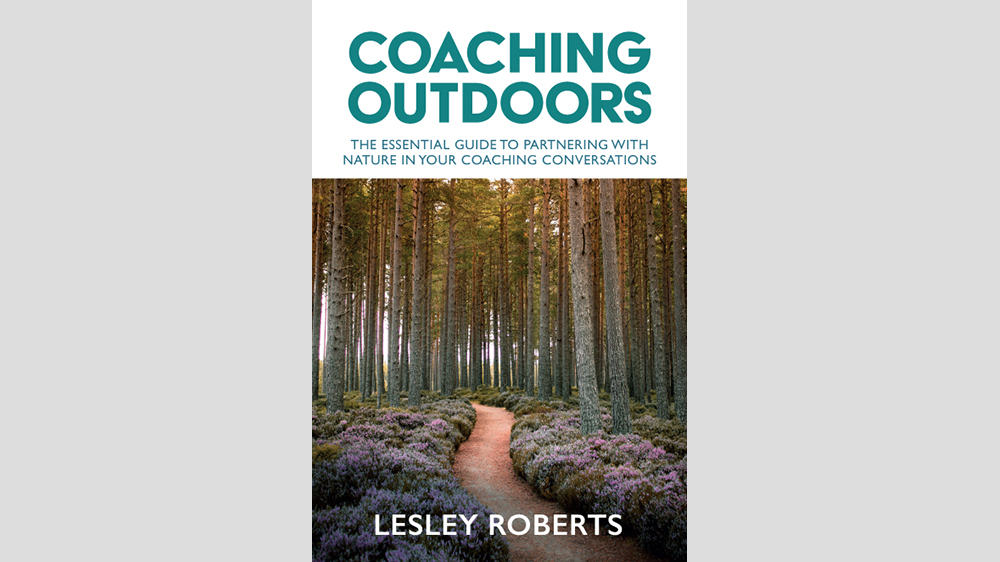
21 July 2023
We recently read Coaching Outdoors by Lesley Roberts, in the EMCC UK Conversations with Authors series. Rachel Woods and Neelam Sharma write below with their thoughts and responses to the book.
‘Kudos to Lesley for bringing such a thorough approach to this book – I’d recommend it to any coach who wants to add this offering to their portfolio.’ Review by Rachel Woods
This is the book I wish I’d written; I’m pleased (and a little green eyed) to say Lesley does it better. It’s a skilful weaving of personal experience, client accounts, practical advice and theory that drive a desire to don a pair of good boots and get out into blue-green spaces for reflection, insight and the magic that only seems to come from connecting with our nature in nature.
I love all the commentary from business people who have experienced being in different (outdoor) environments for their coaching. You can almost sense them smiling as they share their narrative. It seems like they are true converts, nature advocates, and that, to me, is the magic in this offering.
I’m curious as to the difference the environment makes – particularly stepping out of the familiarity and safety of a park and moving into the unknown. Semi-wild and also truly wild spaces and the added dynamic of unsureness and potentially physical challenge – even if it’s only mild discomfort.
I’m delighted by the prominent names from the world of coaching coming onboard with outdoor coaching. In 2017 when I floated my dissertation thesis on the impact of coaching outdoors, I remember no such support and feeling almost dismissed as irrelevant, a bit woo. Clearly, though, as the case has grown, this mindset has shifted, and now coaching outdoors has some big names advocating for it. Kudos to Lesley for bringing such a thorough approach to this book – I’d recommend it to any coach who wants to add this offering to their portfolio.
As a coach and coach supervisor, reading the book has given me a delightful reminder, a nostalgic nudge and additional insight into how powerful metaphors can be. Particularly when those metaphors come from actual physical cues that occur naturally as you pass through an environment. The variables of pace, distance and dynamically live elements (squirrels, birds of prey, loose dogs, etc.) offer live-action metaphors. The experience naturally taps into playfulness and intuition, without feeling forced or contrived. The involvement of movement, the environment and all of the senses opens up endless potential.
I will never stop banging the drum for my own clients to try coming outside. I have access to a stunningly varied and beautiful part of the country (gorges, forests, beaches, chalk downs) and I’m often frustrated by how executives in particular are put off from outdoor coaching by their presumptions of impracticality. In reality, they get so much from it, that it massively outweighs any inconveniences. Maybe that’s the book I need to write to soothe my green eyed monster?’
‘For coaches who are curious about how coaching outdoors could be part of their offering, the book is perfect.’ Review by Neelam Sharma
Coaching Outdoors makes a case for what nature can add to coaching, and importantly it takes a stepwise approach to coaching outdoors with maximum benefit for everyone involved. The book can be read in any order, as the sections lend themselves to be being read independently, but that said, if you are using this as a practical manual, I would read the first three sections together so that by halfway through the book you will be going outdoors with a real client.
For coaches who are curious about how coaching outdoors could be part of their offering, the book is perfect. It is relatable, readable, and above all actionable. In these times where coaching space may not be readily available, and there is a desire to receive the additional benefits of nature, this book provides a solution to the question: Where do I start?
I enjoyed reading the section on the benefits of outdoor coaching, as I am someone who needs to understand the why of doing something. The way the benefits were set out as planet, wellbeing, client, coach, and organisation, made it easy to build a case for working with nature while also offering reasons for an organisation to adopt this methodology of working.
I loved reading the section on rhythm and seasons. The linking of the flow of nature through the four seasons with the creation of coaching questions is ingenious. It planted a seed in my own mind of how to bring in seasonal questions by way of metaphors. Suggested spring coaching questions include: what seeds will you sow? What has begun to grow that needs attention?
Coaching Outdoors made me think that if some of my best conversations happen while walking, and if coaching is about conversations with a purpose, then what is stopping me from taking those conversations outdoors? Actually, quite a lot would have stopped me, because as the book makes clear, there are numerous obstacles, including the weather, how to contract, what to take, planning routes, confidentiality, and so much more. However, because the book addresses these issues, I felt more confident to give this a go.
This book is about leaving the comfort zone of what I believed a coaching conversation was and where it had to take place. I have already added outdoor coaching into my introduction to coaching document, and I bring it up during my chemistry meeting. I want to plan and time some routes so I have a better idea of timings and I am considering inviting more clients to go outdoors with me.